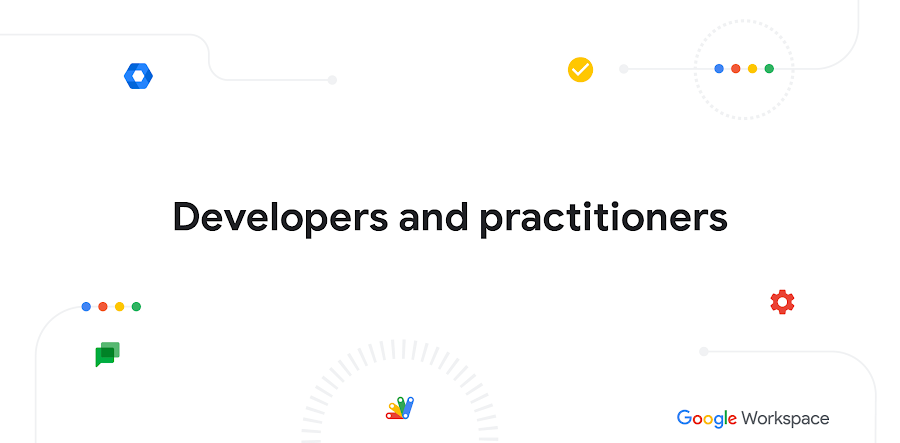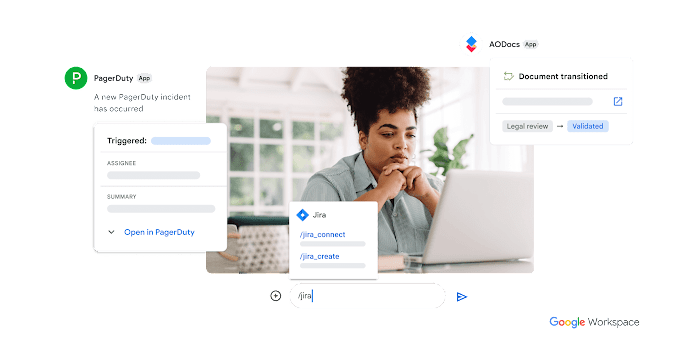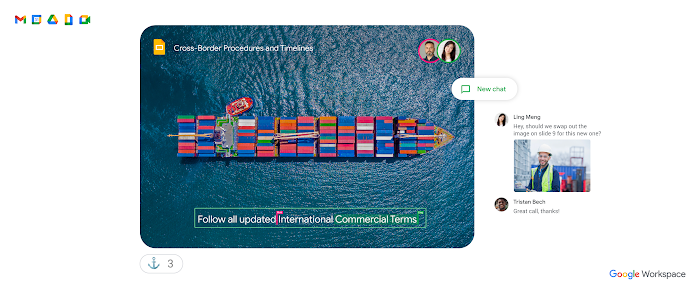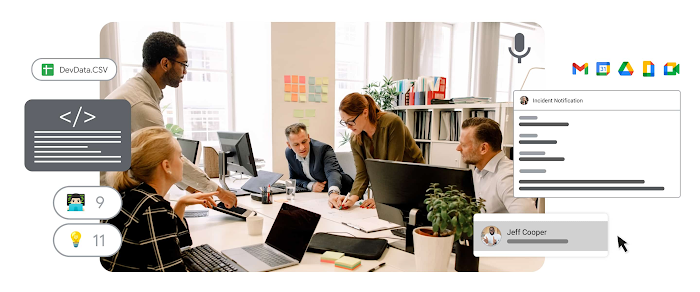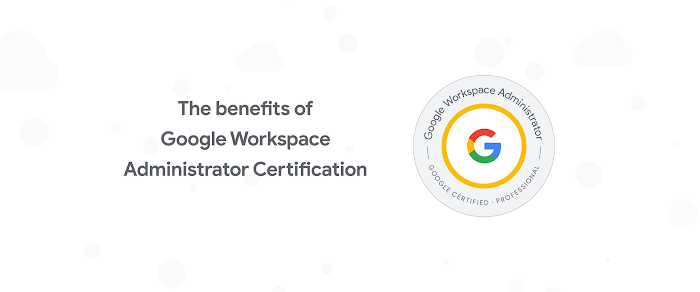Part 2: Hackathons aren’t just for programmers anymore
Jennifer Cadence
Product Marketing Manager
How to successfully organize a no-code development hackathon targeted at citizen developers.
Try Google Workspace at No Cost
Get a business email, all the storage you need, video conferencing, and more.
SIGN UPAs we discussed in our recently published article, no-code hackathons are a great way to empower line-of-business workers and encourage innovation, but they sometimes require different planning steps than traditional hackathons aimed at coders. In this article, we take a look at three questions you should ask yourself to refine the event’s goals, as well as a four-step planning framework and best practices we’ve seen adopted by users of AppSheet, Google Cloud’s no-code application development platform.
One thing to keep in mind: just like a no-code, custom business app, the beauty of a hackathon lies in the fact that each one is a customized effort based on your specific goals. Once you refine your goals, use the framework to build your hackathon. And once you’ve successfully managed your hackathon event, you can use that experience to inform the next one.
Three questions to refine your goals for a hackathon
The hackathon will be many employees’ introduction to the concept and promise of no-code programs, so before any planning for the event itself can occur, enterprises need a refined sense of what the program should achieve and how it will fit into existing operations.
1. What does innovation look like for your organization?
Innovation can mean a number of different things--removing manual processes, improving efficiency in the field, digitizing workflows, and more. Identifying what kind of innovation you hope to spur is important to introducing a no-code platform, and its potential, to the workforce. That said, it is important not to over-prescribe goals: one benefit of democratizing the tools of innovation is that employees often discover and solve challenges that had previously gone unacknowledged.
2. What types of organizational and governance structures will support the no-code program?
It’s obviously powerful to extend app building to more employees, but businesses still need to ensure that no-code efforts don’t redundantly overlap with IT projects. Likewise, they need to avoid Shadow IT problems in which IT lacks visibility into no-code projects, and they need to apply security protections to the corporate digital assets leveraged for no-code apps. All of this means governance and organizational models are important to a successful no-code rollout.
In an IT-centralized model, IT teams create nearly all of the applications to address an organization's needs. In an IT-decentralized program, the broader organization develops the applications within the governance framework provided by IT. Both can encourage non-technical employees to become no-code citizen developers, but they do so in different ways.
For example, in an IT-centralized model, business users might use the no-code platforms to build prototypes, the final versions of which are built by IT. In an IT-decentralized model, non-technical employees throughout the organization might build their own solutions according to governance guardrails set by IT.
3. Beyond hackathons, how will you encourage citizen development?
A hackathon is a great way to drive engagement and hands-on learning, but it’s not the only way to inspire the workforce--and even after a successful hackathon, organizations still need educational and community-building resources to maintain momentum. Many such resources are available, such as AppSheet’s Creator Community. It’s important to look for resources that already exist outside the company, but many successful no-code programs have also invested in internal resources, such as recurring office hours with experts or onboarding programs specific to the company’s goals.
Four key steps for planning a successful no-code hackathon
The preceding questions are a starting point for defining the no-code program’s intentions--but planning and holding a hackathon involves a few more steps. This four-part framework offers some best practices to ensure the event is organized based on your organization’s unique needs.
1. Define your objective
This may seem obvious, but an organization is unlikely to succeed if it holds a hackathon just for the sake of holding an event, without clear goals and intentions. With digital fatigue running rampant, employees aren’t always primed to accept new technical solutions--so to cut through the noise and inspire the workforce, it’s critical to define what the event should achieve.
The goal might be to align your organization's goals with actions individual citizen developers or teams of citizen developers can take. It might be identifying manual tasks that could be automated or potential long-tail solutions. There is no single approach, but often, successful no-code hackathons focus either on functionality or use cases. When a hackathon focuses on functionality, they are often more open-ended but also more likely to produce novel ideas or call attention to challenges that are familiar to line-of-business workers but unknown to leaders. Hackathons built around a specific use case or challenge can be more targeted, but they can also be overwhelming to new citizen developers who are still learning how the no-code platform lets them harness different kinds of functionality.
For example, let’s say my objective is to focus on removing paper from my company’s business processes. The key is not to tell hackathon participants what kind of app to build because I don’t know all the issues they might be struggling with. But every app must digitize something that is now being executed manually. That will be my main criteria for any hackathon app. Of course, I will need to develop a list of questions whose answers will ensure that my objective is being met. These questions will also help my new citizen developers formulate an app building plan and for the most part should focus on the following areas:
Problem. Describe the manual process you want to digitize as well as the paper you want to remove from your process and how it applies to the stated objective.
Scope. Describe what areas of business the problem impacts—is it within an individual scope, or a department, or cross-departmental?
Data. Describe the underlying data you want to digitally capture, where it resides today (in a filing cabinet, transposed to a doc or spreadsheet) and where it should reside electronically.
Solution. Describe how you plan on resolving the problem—how is the app you propose to build going to address the problem? What capabilities does the app need? What features on the app building platform will you be using?
Success metrics. How do you measure success? An increase in productivity measured by a decrease in time spent? Reduction of paper measured by amount digitized?
Recommended best practices: This may seem like a lot of information to collect early in the hackathon process but it provides a structured way to look at an ongoing problem and resolve it. Most citizen developers are new to app building and this type of methodology teaches them how to approach an app building project. This type of approach also serves as a way for departments to identify process issues that may be known or unknown—those long tail applications that provide incremental value and when taken together, may exceed the value of larger, more complex applications. Finally, consider building an app on your no-code platform to collect this information. This signals two things: an overall commitment to digitization as well as a commitment to the platform as the digitization vehicle.
2. Cultivate executive buy-in
Hackathons are usually more successful when company leaders advocate for them. Employees may be uncertain about new technology platforms and tools if the intentions behind and benefits of those resources have not been clearly communicated. Similarly, employees accustomed to existing processes may not adopt new ones if incentives and goals have not been refreshed. These efforts require executive leadership, and when businesses successfully navigate large shifts in technology, the CTO or even CEO is often involved.
Recommended Best Practices: Successful hackathons rely on participation and support from the leadership team as well as IT and line of business management. This participation indicates that citizen development is part of the corporate culture and has the support of the entire company. One member may be designated as the owner or multiple members may be given roles—the more active the support, the more likely it is for employees to get involved. There should be active involvement from the leadership team to promote all hackathon aspects:
Encourage participation. Promoting the hackathon throughout the company via all forms of communication, including email, company and LOB meetings, newsletters, collaboration apps like Google Chat, Slack, or Microsoft Teams, etc.
Acknowledge milestones. Provide snapshots of the hackathon as it progresses, including number of teams participating, number of departments, number of apps being built, first app to be tested, etc. Along with normal forms of communication, consider setting up a Hackathon community page and actively post to it.
Formalize the effort. Host a company-wide event to acknowledge and reward participants. Perhaps the hackathon is a success metrics contest where the winners and runner up receive a prize but make sure that all participants are recognized for their valuable contributions.
3. Anticipate hackathon participants’ needs
Whether a professional or citizen developer, the principles of application development are the same. While no-code application development requires significantly less technical knowledge than traditional application development, it will require training, both during and outside of a hackathon. The more you anticipate, and provide, the necessary training, the more successful your hackathon will be.
Recommended best practices: We’ve seen successful programs that bring in outside experts to guide non-technical workers, others that appoint internal experts, others still that focus on self-learning modules--and some that combine all three. All of these approaches are generally more productive when combined with community-building efforts.
For example, throughout last year, our Creator Community created incredible apps and made them available to fellow community members. COVID-19 Community Support App is one such great example, and the app has now been translated into over 100 languages by creators around the world. Similarly, we saw a number of citizen developers rally around each other during a global hackathon to build COVID-19 support apps, relying on self-guided resources and community support. We’ve also seen companies such as Globe Telecom invest not only in hackathons but also in making experts available for weekly office hours. Many organizations have successfully built citizen developer ecosystems by creating spaces where questions can be posed and discussed. Programs that include specific examples of no-code apps are usually more powerful.
In designing training programs, it can be easy to overlook that hackathon participants need assurances that it is okay to make mistakes--which reinforces the importance of governance. It can also be easy to neglect the data management training that can help citizen developers more easily adopt a no-code platform.
Measures of success are another important training component. Are no-code apps meant to be deployed across the entire organization, to be used by select teams, or to serve as foundations for future proposals? Is a no-code app’s success quantified by hours saved working on a process, number of users for a specific app, or some other metric?
4. Ensure you don’t miss the final ingredients
There are three components, often overlooked, that will determine the overall success of a hackathon:
Make it fun. Gamification can be a terrific way to generate enthusiasm. When an organization incentivizes budding citizen developers with recognition or awards, interest in the no-code program often skyrockets.
Build awareness. No hackathon will succeed if employees aren’t aware of it, so organizers and the leadership team need to get people excited by marketing the event.
Galvanize participation. Will hackathon participants operate as individuals or as members of a team? Most likely, this decision will depend on a number of factors specific to your company with the end result being more employee participation.
Recommended best practices: Gamifying a hackathon cannot only generate enthusiasm but also serve as a way to attract more participants. But don’t just focus on the awards aspect for the winners and runner ups. Think of ways to make it fun for all participants. For example, hackathon T-Shirts, trophies, or plaques for everyone. Or fun award categories for best app idea, first deployed app, etc.
With or without prizes, no hackathon will succeed if employees aren’t aware of it, so organizers and the leadership team need to get people excited by building awareness through marketing the event. The promotions could range from newsletter blurbs to advertisements on internal sites to references during all-hands meetings-- but whatever the venue, this is your chance to communicate both the ways no-code can be empowering as well as any competitions or rewards that the event will entail.
Additionally, one can neither devise gamification strategies nor advertise the event without determining whether hackathon participants will work individually or in teams. Which approach works best may depend on a range of factors, such as whether the organization uses an IT-centralized or IT-decentralized model. But generally, individual participants tend to focus on specific goals whereas teams, by virtue of including more perspectives, can promote community and exploration. If you choose to go with teams, we recommend that you solicit cross-departmental teams or teams from different departments, as this is likely to diversify the solutions and conversations that the hackathon facilitates.
Finally, don’t forget the closing ceremonies! Whether it’s a live judging panel or simply distribution of awards, find a way to celebrate everyone that participated. This goes a really long way in helping the program to gain traction.
Keep the momentum going!
With the preceding questions, framework, and best practices, you’re well on your way to holding a no-code hackathon. Congratulations! But what comes next? Here are four ways to keep the momentum going:
Hold a post-mortem with your team. What are your main takeaways from this event? Should you host another event in the future? Are there any additional goals you need to consider for future events? What would you change for the next one?
Measure your success. Did you meet your objective? Was participation in line with expectations? Did you require a wait list for the event or is the entire organization now trained? What areas can you focus on for your next hackathon?
Double down on citizen development across your organization. After you’ve held your first hackathon event, there will be buzz around all that was accomplished. Those who were not able to participate in the first will likely want to attend the next. If you haven’t already marked your calendar for the next one, determine what date makes the most sense.
Keep a channel open for support. One of the most exciting parts about no-code hackathons is that citizen developers feel empowered to tackle new and bigger problems. In order to achieve this, they need outlets for support. We highly recommend either creating an internal channel for conversation, such as a citizen developer chat room, or pointing them towards a citizen developer community.
We hope you will take this framework and convert it into something that not only meets the unique needs of your organization, but also helps propel you toward a more innovative future. Whether this is just the beginning of your organization's citizen development journey or the next step in an ongoing digital transformation, the possibilities are endless, and we’re excited to see what you build. Click here to learn more about AppSheet, and jumpstart your no-code journey with our library of sample apps.
